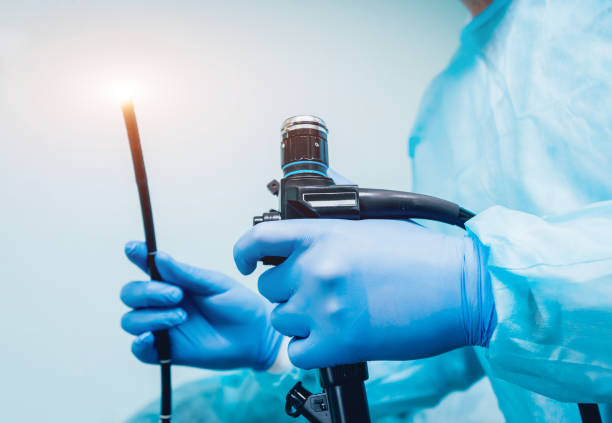Gastroscopy
This is an examination of the oesophagus, the stomach and the first part of the small bowel, called the duodenum, using a flexible tube with a built-in camera.
This is an examination of the oesophagus, the stomach and the first part of the small bowel, called the duodenum, using a flexible tube with a built-in camera.

The procedure is simple and can be done while the person is awake or under sedation.
Gastroscopy provides a look at the inner lining of the structures it passes through for diagnostic purposes.
Also, it allows taking samples (biopsies) of the bowel lining, removing small polyps or foreign bodies and injecting bleeding points to stop the bleeding.
If the procedure is done under deep sedation or anaesthesia then you should not drive, operate machinery, or sign legal documents for 24 hours after.
Colonoscopy (and its short version Flexible Sigmoidoscopy) is an examination method to check the large bowel (colon) through a camera on the tip of a flexible tube passed upstream through the rectum (back passage). It provides a look at the lining of the bowel and helps diagnose problems like inflammation, diverticular disease, ulcers, polyps and cancer.
It also gives the chance to take samples (biopsies) of the bowel lining to be tested under the microscope. Small and medium-size polyps can be removed during the procedure.
To ensure a good look on the colon, the bowel has to be prepared with special agents (e.g., Pico prep). Washing it thoroughly with fluids is very necessary for this purpose.
The flexible sigmoidoscopy uses the same fibre-optic scope but it is inserted to a shorter distance mainly to check the left side of the colon. Only enemas are required for bowel preparation.
Colonoscopies can be done under sedation or general anaesthesia (asleep), while Sigmoidoscopies are typically only done under sedation.
During the Colonoscopy, your doctor will attempt to check the entire colon down to it's beginning where it connects to the small intestine. This is successful in around 90% of patients. In the other 10%, reports around the world demonstrate an incomplete Colonoscopy due to many factors. The reasons for an incomplete Colonoscopy could include excessive bowel looping or narrowing of the bowel which prevents further advancement of the scope.
A Colonoscopy is a relatively safe procedure, however, like with any procedure, is occasionally associated with complications such as perforation (where the bowel tears) or bleeding.
The risk of any of these complications occurring is approximately 2 per 1000 and increases with age when there is intra-abdominal scarring related to previous surgery when polyps that need removal are found, or when multiple biopsies need to be taken.
Bleeding after a Colonoscopy is usually minor and stops spontaneously. It is rarely significant enough to require a blood transfusion. Perforation of the bowel is suspected when the patient develops severe pain after the procedure. If this happens, seek immediate medical advice.
The bowel preparation programme can interfere with the absorption of certain medications. Please inform your doctor if you are on any blood thinners or antibiotics.
Our website uses cookies to help understand and improve your experience. Please let us know if that’s okay by you.
Cookies help us understand how you use our website, so we can serve up the right information here and in our other marketing.